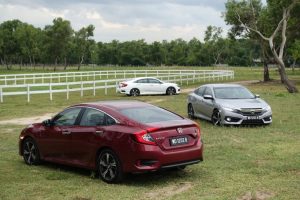ஹோண்டா மலேசியா புதிய நிர்வாக இயக்குனர் மற்றும் தலைமை நிர்வாக அதிகாரி வரவேற்கிறது

டோக்கியி இஷியாமா, அதன் நிர்வாக இயக்குநராகவும், தலைமை நிர்வாக அதிகாரியாகவும் கட்சோடா ஹயாஷி வெற்றி பெற்றதாக ஹோண்டா மலேசியா இன்று அறிவித்துள்ளது.
இஷியாமா 2017 ஆம் ஆண்டு நவம்பர் மாதம் மலேசியாவின் அதிகாரத்தை உத்தியோகபூர்வமாக எடுத்துக் கொள்ளும். தற்போது அவர் ஹோண்டா அட்லஸ் கார்ஸ் (பாகிஸ்தான்) லிமிடெட் தலைவர் மற்றும் தலைமை நிர்வாக அதிகாரி ஆவார்.
48 வயதான இஷியாமாவின் வாழ்க்கை, ஜப்பான், அமெரிக்கா, தாய்லாந்து, சீனா மற்றும் பாக்கிஸ்தான் ஆகியவற்றில் 25 ஆண்டுகளில் பரவியுள்ளது. தாய்லாந்திலும் சீனாவிலும் அதன் நியமிப்புகளின் போது, இஷியாமாமா உள்ளூர் வாகன உறவுகளில் ஆழமாக ஆழமடைந்தது. சந்தை ஆராய்ச்சி மற்றும் தயாரிப்புத் திட்டத்தில் 20 ஆண்டுகளுக்கும் மேலாக அனுபவம் பெற்ற ஹோண்டா மலேசியா, மொத்த தேசிய உற்பத்தியில் பிராண்ட் 1 மற்றும் மொத்த மொத்த தொழில்துறை தொகுதி (TIV) .
மலேசியர்களுக்காக வாங்குதல் மகிழ்ச்சியுடன் பொருட்கள் மற்றும் வாடிக்கையாளர் அனுபவங்களில் அவர் சிறந்து விளங்குவார் என இஷியாமா சுட்டிக்காட்டியுள்ளார். இந்த வருடம் 100,000 யூனிட்டுகள் விற்பனைக்கு வருவதன் மூலம், ஹவாய் மலேசியா மற்றொரு சாதக வருடம் மூலம் ஹயாசி பார்க்கும் மூலோபாயம் இருக்கும் என அவர் நம்புகிறார்.

ஹயாஷி வெற்றிகரமாக ஹோண்டா மலேசியாவின் நிலைப்பாட்டை நான்காவது தேசிய பிரிவில் மற்றும் மொத்த டி.வி.வில் No.2 இல் வெற்றிகரமாக பலப்படுத்தியதுடன், இந்த செயல்முறையிலும், உலகளாவிய ஹோண்டா ஆட்டோமொபைல் செயல்பாட்டினுடனான சந்தையில் பங்கு 1 வது இடத்தை அடைந்தது. அந்த மாதங்களில் சில.
மார்ச் 2017 ஆம் ஆண்டில் 20.5% என்ற அளவில் மிக அதிகமான உள்ளூர் சந்தை பங்குகளை நிறுவனம் அடைந்தது. ஹோண்டா மலேசியாவில் 2016 மார்ச் மாதம் 100,000 விற்பனை பிரிவுகளை பதிவு செய்துள்ளது. அதேபோல் ஹயாசியின் கடிகாரத்தின் கீழ் 600,000 வது உற்பத்திப் பிரிவு.
அடுத்த வளர்ச்சிக்கான ஹோண்டா மலேசியாவை தயார்செய்வதன் மூலம், ஹயாஷி மூலோபாய வாடிக்கையாளர்களுக்கு மேம்பட்ட தொழில்நுட்பத்தை வழங்குவதில் கவனம் செலுத்தியது. அடுத்த தலைமுறை மேம்பட்ட தொழில்நுட்பத்தின் கருப்பின்கீழ், கடந்த ஆண்டு அறிமுகப்படுத்தப்பட்டது டர்போசார்ஜிங் இயந்திரம். மலாய்க்காரர்களுக்கு ஒரு விருப்பமாக டர்போசார்ஜ்டு எஞ்சின் கொண்ட சிவிக் வெற்றியைக் கொண்டு ஹயாஷி மிகவும் மகிழ்ச்சி அடைந்தார். சிவிக் உள்ளூர் உற்பத்திக்காக டர்போஜெஞ்ச் இயந்திரத்துடன் பொருத்தப்பட்ட மலேசியாவில் முன்னோடி உற்பத்தி செய்யும் ஜப்பானிய மாதிரி ஆகும்.

இந்த மையம், விளையாட்டு கலப்பின i-DCD வகைகளின் அறிமுகத்துடன் மேலும் விரிவடைந்தது, ஜப்பானில் தயாரிக்கப்படும் மிகவும் உயர்ந்த ஏற்றுக்கொள்ளப்பட்ட சுற்றுச்சூழல்-நட்பு பாயிட்ரைனை அறிமுகப்படுத்துவதன் மூலம், இது காரில் இருந்து இயங்கக்கூடிய உறுப்பு உறுதியை சமரசம் செய்யாது. இன்று வரை, மலேசியாவில் கலப்பின பிரிவின் தலைவராக ஹோண்டா மலேசியா உள்ளது. ஹோண்டா மலேசியா புதிய புதிய CR-V அறிமுகப்படுத்தப்பட்டது, இது புதிய நிலை மேம்பட்ட பாதுகாப்பை வழங்க ஹோண்டா சென்ஸிங் உடன்.
இதற்கிடையில், விரைவான முன்னணி சக்கர இயக்கி உற்பத்தி கார் என பதிவு செய்யப்படும் சீக்கிரம் ரைட் ரைட் விரைவில் அறிமுகப்படுத்தப்படும், வாடிக்கையாளர்களின் மகிழ்ச்சியைத் தருகிறது. மொத்தத்தில், ஹயாஷி ஹோண்டா மலேசியாவின் ஐந்து புதிய மாடல்களை அறிமுகப்படுத்தியதுடன் மொத்தமாக 90 ஹோண்டா விற்பனையாளர்களையும் நாட்டிற்கு கொண்டு சென்றது.
ஹோண்டா ஹோண்டா தலைமையிலான ஹயாஷி, ஹில்டா ஹோண்டாவில், ஓன்சீஸ் ஆபரேஷன் டிவிஷன் (அமெரிக்காஸ்), பிராந்திய ஆபரேஷன் (வட அமெரிக்கா), ஹோண்டா மோட்டார் கோர், லிமிடெட் ஜப்பானில்.




